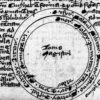Icelandic Manuscript 16th & 17th Century
ms ATA Ämb2
There are very few Galdrabóks (Magic Books) left today, especially in complete form. Many were burned as heretic books and others were hidden away by their owners to later be forgotten and decay into nothing in some nameless hiding-spot. Those that have survived however, can now be found stored away in several Scandinavian archives, while others are tucked away in private collections.
Back in the day, there were a lot of rumours of black art books like this one in existence. Books said to contain powerful magic in the form of depicted Galdrastafir, Spells, Troll-runes and more. One of the most famous historical manuscripts of this kind is the mythical “Raudskinna” (Red Skin). This fabled manuscript was said to have been written by the Icelandic bishop Gottsálkur Nikolásson (1498-1520’s), who was considered a very cruel man, and also one of the most powerful Troldmænd of his time. “Raudskinna” was lost to the ages unfortunately, as the story says the Bishop took it with him to his grave.
This Galdrabók, however, is one of those manuscripts that survived. It’s actually one of the more infamous of the surviving black art books that still exist. It’s a small book compiled on parchment, consisting of 32 sheets in all. The oldest parts of the document were written down in Iceland sometime during the 16th century. Later, the book found its way to Denmark, and at the beginning of the 17th century a Danish Troldmand (sorcerer) supplemented the manuscript with more content. Alas, a more exact date for when this happened is obscured, along with the names of those who wrote the text. Some of the content is likely to originate from other Galdrabóks, but it’s really hard to say at this point.
In 1682 the manuscript was bought in Copenhagen by the Swedish language- and forn-researcher Johan Gabriel Sparfwenfeldt. During 1689-1694 he worked hard on collecting several “gothic” memorials and manuscripts for the Swedish Antiquity Archive.
In 1786 the Swedish Antiquity Archives was placed under management of the Royal History and Antique Academy, and this is where the manuscript can be found today – indexed and shelved as ATA ÄMB2.
Made available by Galdrastafir.org initially created by Ræveðis.




